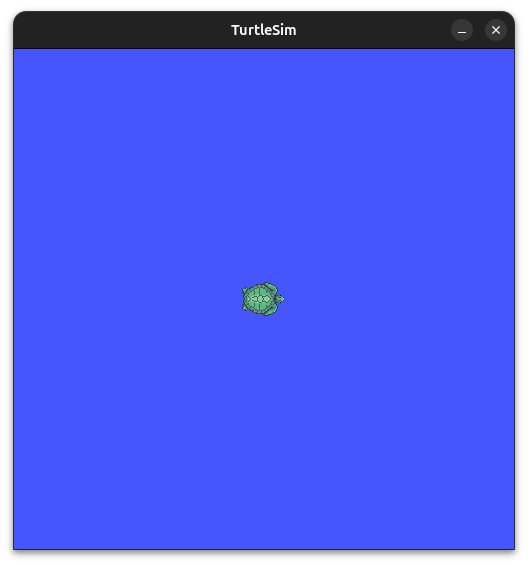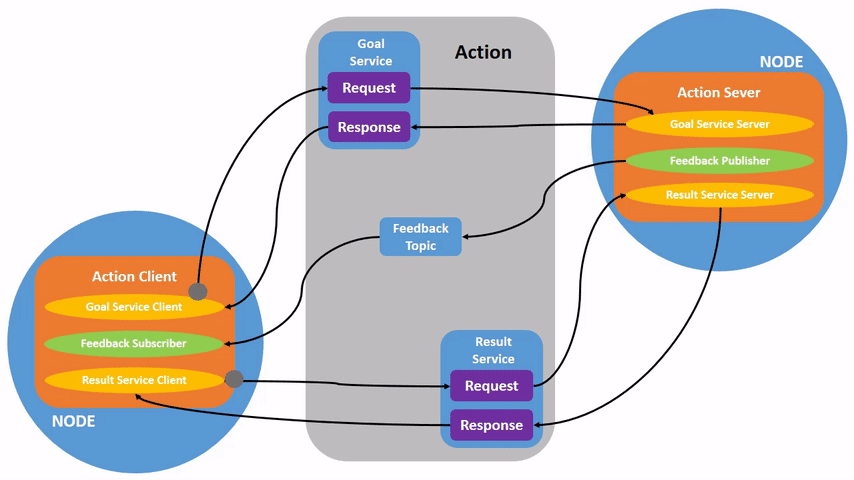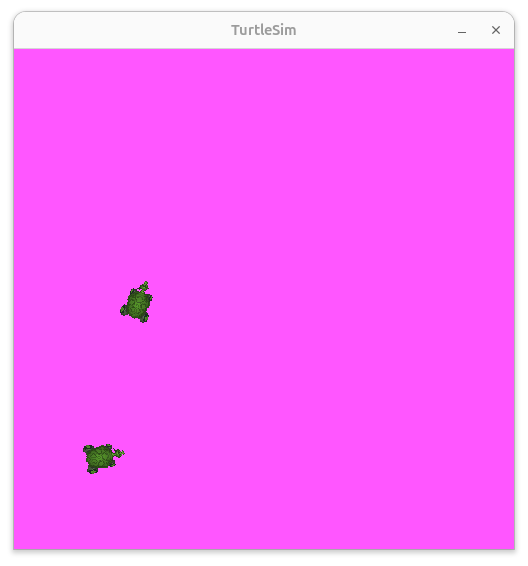03 - ROS bags, services, actions and parameters
Robotics I
Poznan University of Technology, Institute of Robotics and Machine Intelligence

Laboratory 3: ROS - bags, services, actions and parameters
Goals
- Recap ROS 2 concepts - nodes and topics
- Familiarize with with ROS 2 bags, services, actions and parameters
- Get hands-on experience with the ROS 2 functionalities
- Experiment with TurtleSim simulation
Resources
- ROS 2 Documentation
- Recording and playing back data in ROS 2
- ROS 2 Services
- ROS 2 Actions
- ROS 2 Parameters
- Understanding ROS 2 parameters
- ROS 2 parameters command-line tool
- TurtleSim in ROS 2
TurtleSim

TurtleSim is a lightweight simulator for learning ROS 2. It illustrates what ROS 2 does at the most basic level to give you an idea of what you will do with a real robot or a robot simulation later on.
In today’s lab we will be using TurtleSim to practice ROS 2 functionalities in simulated environment. With TurtleSim you can to send velocity commands, subscribe to topics, and handle basic robot control in a fun and engaging way.
To start simulator call:
ros2 run turtlesim turtlesim_nodeWhile to start keyboard control, from the second terminal call the command:
ros2 run turtlesim turtle_teleop_keyTasks
Note 1: Everything we do today should be done inside
the container! To attach another terminal to a running container use the
command docker exec -it <CONTAINER NAME> bash.
Note 2: Every time you open a terminal window and
want to work with ROS 2 you need to source environmental variables using
source /opt/ros/$ROS_DISTRO/setup.bash or
source install/setup.bash if you work in a specific ROS 2
workspace (e.g. ~/ros2_ws)!
- Run docker container based on osrf/ros:jazzy-desktop-full
docker image with GUI support. Use
docker_run.shscript provided below.
docker_run.sh
IMAGE_NAME="" # <DOCKER IMAGE REPOSITORY>:<DOCKER IMAGE TAG>
CONTAINER_NAME="" # student ID number
xhost +local:root
XAUTH=/tmp/.docker.xauth
if [ ! -f $XAUTH ]
then
xauth_list=$(xauth nlist :0 | sed -e 's/^..../ffff/')
if [ ! -z "$xauth_list" ]
then
echo $xauth_list | xauth -f $XAUTH nmerge -
else
touch $XAUTH
fi
chmod a+r $XAUTH
fi
docker stop $CONTAINER_NAME || true && docker rm $CONTAINER_NAME || true
docker run -it \
--env="ROS_AUTOMATIC_DISCOVERY_RANGE=LOCALHOST" \
--env="DISPLAY=$DISPLAY" \
--env="QT_X11_NO_MITSHM=1" \
--volume="/tmp/.X11-unix:/tmp/.X11-unix:rw" \
--env="XAUTHORITY=$XAUTH" \
--volume="$XAUTH:$XAUTH" \
--privileged \
--network=host \
--name="$CONTAINER_NAME" \
$IMAGE_NAME \
/bin/bash- Install turtlesim package and verify installation following the steps provided in Install TurtleSim.
- Start TurtleSim with command
ros2 run turtlesim turtlesim_nodeand from another terminal explore available nodes and topics. Then, runros2 run turtlesim turtle_teleop_keycommand that allows you to to control the turtle. From the third terminal observe how topic /turtle1/pose changes when you moves the turtle. Take a screenshot of TurtleSim simulator alongside terminal with preview of /turtle1/pose topic and upload it to eKursy. - Topic /turtle1/cmd_vel, which is responsible for
controlling the turtle’s movement, is of type geometry_msgs/msg/Twist.
Use the
ros2 topic pubcommand to publish the turtle control commands. - Keep the turtlesim_node running.
ROS 2 Bags
ROS 2 bag is a command line tool for recording and playing back data published to topics and services in your ROS 2 system. It allows users to capture any number of topics and services from sensors, robots, or other devices during experiments or testing and replay it later for debugging, analysis, or simulation purposes. The bag files store the messages in a time-ordered manner in a database, making them useful for offline data analysis and system development. It is intended to be high performance and avoids deserialization and reserialization of the messages. The idea is to:
- have a way of recording the data from multiple components at once
- have a way of replaying the same data in the same way
- have a deterministic and repeatable method for the system’s performance verification
ROS 2 bag has the following subcommands, which can be inspected by calling:
$ ros2 bag -h
Commands:
burst Burst data from a bag
convert Given an input bag, write out a new bag with different settings
info Print information about a bag to the screen
list Print information about available plugins to the screen
play Play back ROS data from a bag
record Record ROS data to a bag
reindex Reconstruct metadata file for a bagros2 bag record --topics <TOPIC 1 NAME> <TOPIC 2 NAME>ros2 bag record --allOnce some data has been recorded, you can stop the recording from the terminal with `ros2 bag record’ by pressing CTRL+C. As a result you should see a folder containing a database with ROS 2 bag data corresponding to the time of recording, i.e. rosbag2_2025_03_17-18_26_12/. To inspect the ROS 2 bag, run:
ros2 bag info <PATH TO ROS 2 BAG FILE>The output should be structured as follows:
Files: rosbag2_2025_03_18-07_14_08_0.mcap
Bag size: 334.3 KiB
Storage id: mcap
ROS Distro: jazzy
Duration: 38.641391213s
Start: Mar 18 2025 07:14:08.054556029 (1742282048.054556029)
End: Mar 18 2025 07:14:46.695947242 (1742282086.695947242)
Messages: 4879
Topic information: Topic: /events/write_split | Type: rosbag2_interfaces/msg/WriteSplitEvent | Count: 0 | Serialization Format: cdr
Topic: /parameter_events | Type: rcl_interfaces/msg/ParameterEvent | Count: 2 | Serialization Format: cdr
Topic: /rosout | Type: rcl_interfaces/msg/Log | Count: 15 | Serialization Format: cdr
Topic: /turtle1/cmd_vel | Type: geometry_msgs/msg/Twist | Count: 30 | Serialization Format: cdr
Topic: /turtle1/color_sensor | Type: turtlesim/msg/Color | Count: 2416 | Serialization Format: cdr
Topic: /turtle1/pose | Type: turtlesim/msg/Pose | Count: 2416 | Serialization Format: cdr
Service: 0
Service information:To play recorded ROS 2 bag file, simply call:
ros2 bag play <PATH TO ROS 2 BAG FILE>ROS 2 Services
In ROS 2 services are another method of communication between nodes. While topics are based on publisher-subscriber model, services follow a call-and-response model. Therefore, services only provide data when they are specifically called by a client, unlike topics which allow nodes to subscribe to data streams and get continual updates. To check subcommands of ROS 2 services simply call:
$ ros2 service -h
Commands:
call Call a service
echo Echo a service
find Output a list of available services of a given type
info Print information about a service
list Output a list of available services
type Output a service's type
 https://docs.ros.org/en/jazzy/Tutorials/Beginner-CLI-Tools/Understanding-ROS2-Services/Understanding-ROS2-Services.html
https://docs.ros.org/en/jazzy/Tutorials/Beginner-CLI-Tools/Understanding-ROS2-Services/Understanding-ROS2-Services.html
To check available services call:
ros2 service listIn our case, when turtlesim_node is running, the list of services should be as follows:
/clear
/kill
/reset
/spawn
/turtle1/set_pen
/turtle1/teleport_absolute
/turtle1/teleport_relative
/turtlesim/describe_parameters
/turtlesim/get_parameter_types
/turtlesim/get_parameters
/turtlesim/get_type_description
/turtlesim/list_parameters
/turtlesim/set_parameters
/turtlesim/set_parameters_atomicallyLet’s look more closely at the /clear service using:
$ ros2 service info /clear
Type: std_srvs/srv/Empty
Clients count: 0
Services count: 1This service is empty, which means that it takes no arguments when the service is called (i.e., it sends no data when making a request and receives no data when receiving a response).
Let’s call this service. To do this, use command
ros2 service call with the following parameters:
ros2 service call <SERVICE NAME> <SERVICE TYPE>In our case it will be:
ros2 service call /clear std_srvs/srv/EmptyNow, let’s look at the case where the service has arguments, i.e., /spawn, which allow us to spawn a new turtle at a given location and orientation. To inspect service content, firstly check service type:
$ ros2 service type /spawn
turtlesim/srv/SpawnThen, using ros2 interface show command, inspect content
of the service:
$ ros2 interface show turtlesim/srv/Spawn
float32 x
float32 y
float32 theta
string name # Optional. A unique name will be created and returned if this is empty
---
string nameLet’s create a new turtle using /spawn service:
ros2 service call /spawn turtlesim/srv/Spawn '{x: 2, y: 2, theta: 0.2}'After calling this command, a new turtle named turtle2 appeared in the place we specified in a service parameters

To remove additional turtles and clear simulation, simply call:
ros2 service call /reset std_srvs/srv/EmptyROS 2 Actions
In ROS 2, actions are a type of communication intended for long-running tasks, consisting of three parts: a goal, feedback, and a result. Actions are based on topics and services. Their functionality is similar to services, except actions can be canceled. They also provide steady feedback, as opposed to services which return a single response. An action client node sends a goal to an action server node, which acknowledges the goal and returns a stream of feedback and a result. To inspect subcommands related to ROS 2 actions call:
$ ros2 action -h
Commands:
info Print information about an action
list Output a list of action names
send_goal Send an action goal
type Print a action's type
 Source:
https://docs.ros.org/en/jazzy/Tutorials/Beginner-CLI-Tools/Understanding-ROS2-Actions/Understanding-ROS2-Actions.html
Source:
https://docs.ros.org/en/jazzy/Tutorials/Beginner-CLI-Tools/Understanding-ROS2-Actions/Understanding-ROS2-Actions.html
To check available actions call:
ros2 action listIn our case, each turtle has only one action -
/turtle1/rotate_absolute. To inspect this action firstly
check its type calling:
$ ros2 action type /turtle1/rotate_absolute
turtlesim/action/RotateAbsoluteThen, using ros2 interface show command, inspect content
of the action:
$ ros2 interface show turtlesim/action/RotateAbsolute
# The desired heading in radians
float32 theta
---
# The angular displacement in radians to the starting position
float32 delta
---
# The remaining rotation in radians
float32 remainingLet’s perform an action by calling the command:
ros2 action send_goal /turtle1/rotate_absolute turtlesim/action/RotateAbsolute '{theta: 1.2}'ROS 2 Parameters
A parameter
is a configuration value of a node, allowing storing and manipulating
node settings. They can be stored as integers, floats, booleans,
strings, or lists. In ROS 2, each node maintains its own parameters,
which can be set from the command line or using YAML file. In simple
cases, YAML looks very natural: 1 is an integer,
1.0 is a float, one is a string,
true is a boolean, [1, 2, 3] is a list of
integers. ROS 2 has many commands that can be used on parameters. You
can find them by calling:
$ ros2 param -h
Commands:
delete Delete parameter
describe Show descriptive information about declared parameters
dump Show all of the parameters of a node in a YAML file format
get Get parameter
list Output a list of available parameters
load Load parameter file for a node
set Set parameterTo list available parameters call:
ros2 param listFor TurtleSim node, the list of parameters looks like this:
/turtlesim:
background_b
background_g
background_r
holonomic
qos_overrides./parameter_events.publisher.depth
qos_overrides./parameter_events.publisher.durability
qos_overrides./parameter_events.publisher.history
qos_overrides./parameter_events.publisher.reliability
start_type_description_service
use_sim_timeTo show descriptive information about declared parameter(s) use
describe subcommand:
ros2 param describe <NODE NAME> <PARAMETER NAME> [<PARAMETER NAME>]To get parameter simply call:
ros2 param get <NODE NAME> <PARAMETER NAME>While to show all of the parameters of a node in a YAML file format use the command:
ros2 param dump <NODE NAME>To set parameter use the command:
ros2 param set <NODE NAME> <PARAMETER NAME> <VALUE>While when you plan to set more than one parameter it may be
convenient to use the load subcommand. It loads a
YAML file.
ros2 param load <NODE NAME> <PARAMETER FILE>Parameters background_b, background_g, and background_r refer to background window color, so let’s change it! For example call:
ros2 param set /turtlesim background_r 255The result is as follows:

Tasks
Note 1: Everything we do today should be done inside
the container! To attach another terminal to a running container use the
command docker exec -it <CONTAINER NAME> bash.
Note 2: Every time you open a terminal window and
want to work with ROS 2 you need to source environmental variables using
source /opt/ros/$ROS_DISTRO/setup.bash or
source install/setup.bash if you work in a specific ROS 2
workspace (e.g. ~/ros2_ws)!
- Use
ros2 param dumpto save the current node parameters to the YAML file. Using the VS COde IDE, attach a docker container and open the previously saved YAML file. Change the values of the parameters background_b, background_g and background_r to whatever you want and save the file. Then load it and check how the background color was changed. Upload the eKursy YAML file and a screenshot of the TurtleSim window. - Use ROS 2 bag commands to record turtle control commands (~60
seconds) and then play them back to reproduce the object’s movements.
Run the TurtleSim simulator and from the second terminal run the
keyboard control node
(
ros2 run turtlesim turtle_teleop_key). In another terminal, start recording all topics while manipulating the turtle from the terminal running the turtle control node. After a while stop recording and reset the simulator window by calling the ROS 2 /reset service. Finally, play the ROS 2 bag file and watch the turtle reproduce the movements. Upload the recorded ROS 2 bag file to eKursy.